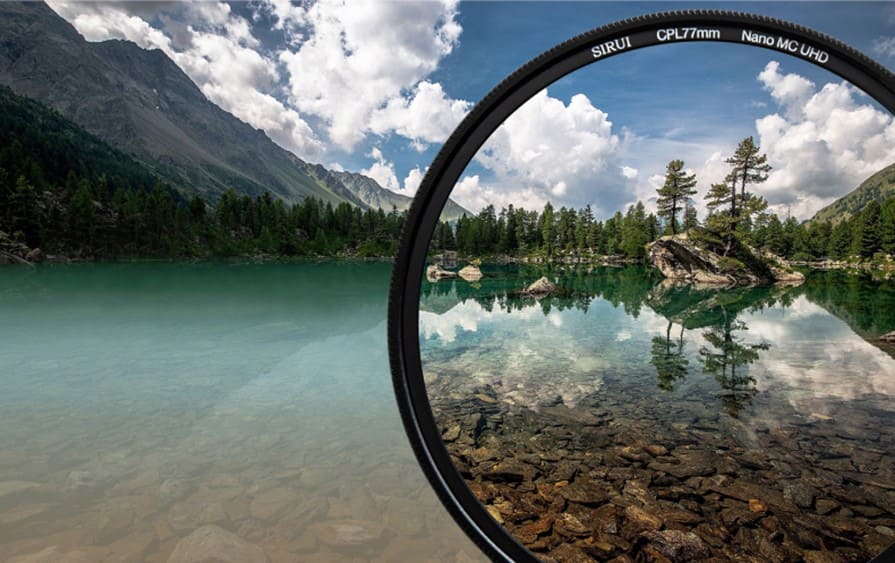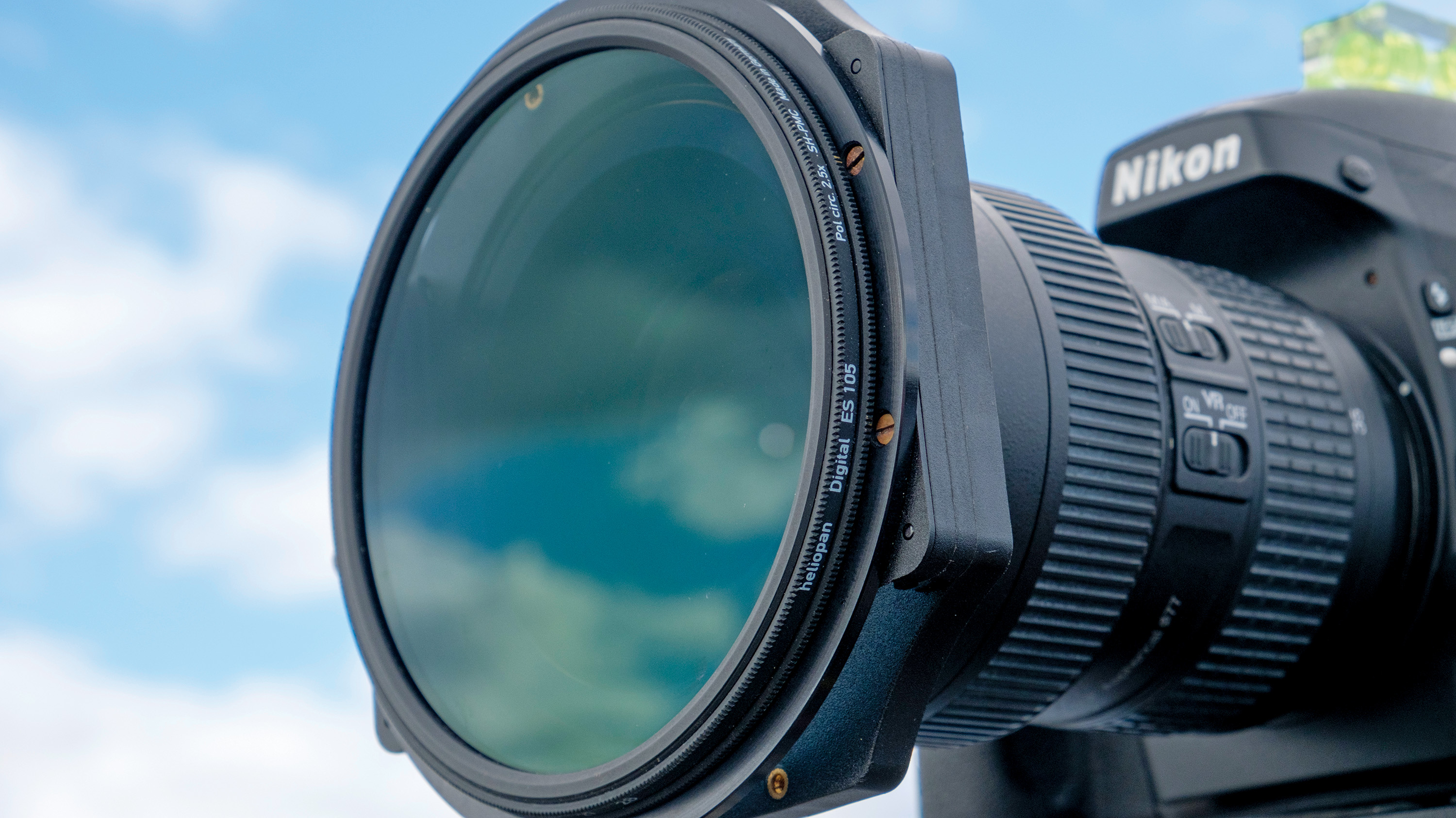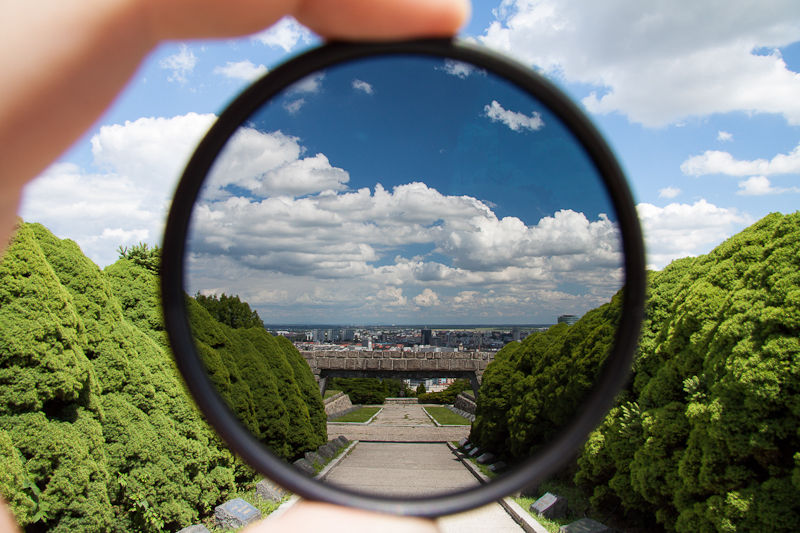INTRODUCTION
Clarity in photography refers to an image's sharpness and accuracy, with details that are well-defined and easily discernible. It is critical in producing visually attractive and powerful images.
Clarity improves the overall quality of the image, allowing viewers to interact with the shot on a deeper level, whether shooting landscapes, portraits, or any other topic. Photos that lack clarity may look hazy, lack information, and fail to express the desired message or aesthetics.
As a result, knowing and emphasizing clarity is critical for photographers seeking to improve the visual impact of their work.
Polarizer lenses in cameras serve an important role in improving clarity by decreasing glare, reflections, and atmospheric haze in photos.
These lenses are made to selectively filter and block particular polarized light waves, allowing photographers to capture photographs with higher contrast, color saturation, and overall clarity.
Polarizer lenses help to crisper and more colorful pictures by reducing undesired reflections on surfaces such as water or glass and cutting through ambient haze.
They essentially assist photographers in "unlocking the power of clarity" by increasing the quality and visual impact of their photographs.
Basics of Camera Polarizer Lenses
Polarizer lenses are defined and functioned by their capacity to decrease glare and undesirable reflections in photos. A polarizer lens has a unique filter that selectively blocks specific polarized light wavelengths.
When light reflects off nonmetallic surfaces such as water or glass, it becomes polarized, resulting in glare and reflections that can impair visual quality.
Functions
A polarizer lens's job is to reduce or remove this polarized light, which has many important advantages for photographers:
Reduced Glare: Polarizer lenses dramatically minimize glare from reflecting objects like as water or glass, providing for clearer and more colorful views.
Enhanced Contrast: By removing undesired reflections, polarizers increase overall contrast in a scene, making colors look more saturated and details more prominent.
Richer Colors: Polarizer lenses can increase the saturation of colors in the sky, foliage, and other features, resulting in more vibrant and eye-catching images.
Enhanced Clarity: The decrease of polarized light adds to enhanced overall vision clarity, particularly in outdoor conditions with strong sunshine.
Reduction of glare and reflection:
Polarizers reduce glare and reflections by selectively blocking certain polarized light waves. When light reflects off surfaces such as water, glass, or shiny objects, it becomes polarized, which means its waves oscillate in specific directions.
A polarizer lens is designed to allow light waves vibrating in one direction to pass through while blocking those vibrating in another.
Types of polarizers available in market:
Linear Polarizers: The most common form of polarizer. Reduces glare and reflections effectively Used mostly with manual focus cameras.
Circular Polarizers: A more sophisticated variant of linear polarizers.Cameras with autofocus are compatible.Adds an extra layer to solve focusing and metering difficulties in current DSLRs and mirrorless cameras.
Colour-Enhancing Polarizers: Polarizers that are designed to enhance certain hues in a picture. Ideal for bringing out the blue in the sky or the green in the vegetation. Polarization and colour enhancement are both available in a single lens.
Combos of Variable ND (Neutral Density) and Polarizer: Combine the benefits of a polarizer with variable neutral density.Controls both polarization and exposure settings in a single lens.
Polarizers with specialized properties:Designed for specialized settings such as underwater photography or harsh lighting conditions.Provide distinctive characteristics or finishes to solve unique difficulties.
The Science Behind Clarity:
Polarizer lenses operate by selectively blocking or allowing light waves in a given orientation to flow through. Here's a quick rundown of how polarizer lenses enhance image quality:
Orientation of Incoming Light: Natural light is made up of waves that vibrate in different directions. When light reflects off non-metallic materials such as water or glass, it becomes polarized, which means that the waves mainly oscillate in one direction.Polarizer lenses are constructed with a specific filter that can be spun to selectively block or let light waves depending on their orientation. You may change the quantity of polarized light entering the camera lens by changing the polarizer.
Reduced glare and reflections:Scattering polarized light causes glare and reflections, which can reduce visual quality. Polarizer lenses significantly minimize glare and reflections by selectively filtering polarized light, resulting in clearer and more colorful pictures.
Contrast and color enhancement: Polarizers increase contrast in a scene by removing undesirable reflections and glare. Colors look more rich and bright because the polarizer lets actual colors to shine through without interference from polarized light.
Clarity and Detail Enhancement:The removal of air haze and reflections improves the visibility of distant objects. Fine details become more noticeable, especially in landscape and outdoor photography.
physics of light polarization:
Understanding how light waves oscillate in a given direction is crucial to the mechanics of light polarization. Light is an electromagnetic wave with an electric field that oscillates perpendicular to its propagation path.
When light strikes a reflecting or refractive surface, it becomes polarized, which means that its oscillations align mostly in one direction.A polarizer lens works by selectively blocking light waves vibrating in specific orientations while allowing light waves oscillating in a specific plane to flow through.
In photography, this method eliminates glare, decreases reflections, and improves clarity. Polarized light waves aid in the filtering of undesired dispersed light, leading in increased visual contrast and detail, particularly in outdoor environments with reflecting surfaces such as water or glass.
Real-world examples:
Describe a scenario in which you were photographing a picturesque environment with water reflections or a bright sky.Show how the use of a polarizer lens decreased glare on the water's surface, resulting in clearer and more colorful reflections.
Outdoor photographs: Tell us about your experience taking photographs in direct sunshine.Describe how a polarizer reduced glare on the subject's skin, creating more equal lighting, and enhancing facial features.
Architecture Photography: Talk about a time when you were shooting a structure with glass surfaces. Demonstrate how the polarizer reduced undesired reflections on the glass, giving for a better view of the architectural elements.
Nature & Wildlife: Show an example of a zoo shot taken through greenery or glass.Highlight how the polarizer reduced reflections or glare, resulting in clearer, more detailed pictures.
Travel Photography: Capture a lively street scene in great sunshine to tell a story.Describe how the polarizer increased color saturation and decreased air haze, resulting in clearer and more visually appealing vacation images.
Choosing the Right Camera Polarizer Lens
Compatibility with Your Camera: Determine whether the polarizer lens is compatible with the model of your camera. Check that the lens size corresponds to the filter thread size of your camera lens.
Polarizer Type: Depending on your camera's focusing mechanism, choose between linear and circular polarizers. Circular polarizers are commonly used in current autofocus systems.
Glass Quality: Take into account the quality of the lens glass to provide excellent clarity and minimal distortion.High-quality optical glass aids in the preservation of picture sharpness and color fidelity.
Coating and Anti-Reflective Properties: Look for multi-coated lenses to prevent flare and ghosting. Anti-reflective coatings increase image quality by increasing light transmission.
Rotating Ring Design: Choose a polarizer lens with a rotating ring for simple polarization adjustment. This function allows you to adjust the polarization level dependent on the shooting conditions.
Build Quality and Durability:Consider the lens's build quality, especially if you want to use it in harsh outside circumstances.The lens's durable structure guarantees that it can endure a variety of environmental variables.
Budget and price:Determine your budget and look for polarizer lenses that are inside it.Cost should be balanced against the functionality and quality required for your unique photographic needs.
Efficacy in Various Situations: Examine how effectively the polarizer works under different lighting settings.Consider its ability to reduce glare, increase color saturation, and improve contrast.
Compatibility with different camera models
In the context of camera polarizer lenses, "compatibility with different camera models" refers to how well a certain polarizer lens works with a range of camera brands and models. Here's a quick rundown:
Camera polarizer lenses are available in a variety of sizes and thread mounts to accommodate various camera lens diameters.
The polarizer lens you select must be compatible with the filter thread size of your camera lens. The thread size of the filter is normally marked on the front of the lens and is measured in millimeters.
If your camera lens has a 58mm filter thread, you must choose a polarizer lens with a 58mm diameter. Because different lenses have different filter thread sizes, compatibility guarantees that the polarizer attaches firmly to your lens without producing vignetting or other difficulties.
Furthermore, compatibility may relate to the polarizer's design and characteristics in regard to the camera's functions.
Certain sophisticated camera types may have additional needs or features that enhance the usage of polarizer lenses.
Checking for compatibility guarantees that the polarizer will work perfectly with your camera system, delivering maximum image quality and performance.
Budget considerations and available features
considerations for the Budget: Discuss various pricing points for camera polarizer lenses. Make it clear that there are solutions for all budgets. Make recommendations for high-quality lenses in various pricing ranges. Give people advice on how to balance cost with their photographic demands.
Available Features: Describe the characteristics of camera polarizer lenses, such as multi-coating, filter thickness, and compatibility with certain camera types. Explain how different characteristics help to improve image quality and durability.
Assist readers in determining which characteristics are vital for their photographic style. Adjustable rings, convenience of use, and adaptation to diverse shooting circumstances are all considerations to consider.
Tips for Using Camera Polarizer Lenses
installation and adjustment
Installation: Check that the lens is clean: Before connecting the polarizer, clean the front element of your camera lens to eliminate any dust or smudges.
Correctly thread the polarizer: Screw the polarizer onto the lens in the manufacturer's recommended direction. Make sure not to cross-thread it.Tighten the polarizer tightly to prevent it from moving during shooting.
Adjustment: Most polarizers are circular and may be rotated while still connected to the lens. Rotate the object till you get the desired effect. Looking via the viewfinder: As you spin the polarizer, look through the camera's viewfinder or utilize the live view on the screen to see variations in glare, reflections, and overall picture clarity.
Experiment with angles: The best polarization angle may differ depending on the shooting conditions. Experiment with several angles to determine the ideal position for decreasing glare and improving clarity.
Keep an eye on the scene's impact: Take note of how the polarizer changes the scene's colors, contrast, and overall visual attractiveness. Make changes until you get the desired outcome.
Rotating the polarizer can increase or lessen the intended effects depending on the angle of the sun or the reflecting surfaces in your area. This approach aids in the reduction of undesired reflections or glare, hence improving overall image quality.
Optimizing for Different Lighting situations: It is critical to understand how different lighting situations impact polarization. Adjusting the polarizer to obtain best results in bright sunshine, cloudy skies, or during the golden hour, for example, may provide clarity in a variety of lighting scenarios.
Balancing Polarization and Composition: While a polarizer may increase clarity greatly, its usage must be balanced with other compositional considerations. This includes thinking about how polarization affects the overall appearance of the image and making sure it matches the photographer's artistic goal.
Angle Experimentationand Subjects: Experimentation is essential for determining the ideal settings for maximum clarity. To attain the required amount of clarity, photographers might experiment with different angles and viewpoints to examine how polarization affects certain subjects such as water, vegetation, or sky.
Understanding limits: It is critical to understand the limits of polarizer lenses. A polarizer may have no effect in some scenarios, such as low-light situations or when capturing non-reflective materials. Knowing when and how to utilize a polarizer effectively helps to maximize clarity in a variety of shooting situations.
Creative Applications of Polarizer Lenses:Enhancing color saturation and vibrancy" refers to a camera polarizer lens's ability to heighten and make colors in a shot look more bright and energetic. Light that bounces off surfaces may cause glare and wipe out colors.
A polarizer lens lowers glare by selectively allowing light waves aligned in one direction to pass while blocking others. As a consequence, undesirable reflections are reduced, and the actual colors of the scene are highlighted.
In practice, utilizing a polarizer may make blue sky appear deeper and richer, vegetation appear more bright, and colors in general stand out more. This effect is most visible in landscape and nature photography. Photographers frequently employ
Polarizer lenses are used by photographers to improve the visual appeal of their photos by capturing more saturated and brilliant colors, resulting in a more spectacular and appealing end result.
Using a camera polarizer lens to increase the visual quality and details in landscape shots is referred to as capturing landscapes with greater clarity.
The polarizer lowers glare and reflections from objects such as water and vegetation, allowing the camera to capture more bright and clear photographs.
This gain in clarity is especially useful when capturing outdoor landscapes with a variety of features, such as mountains, lake bodies, and sky, where undesired reflections and air haze may frequently degrade image quality.
A polarizer can help cut through these difficulties, resulting in clearer, more defined landscape photographs with better colors and contrast.
Portrait photography frequently seeks to capture the subject's personality and expression, and polarizers can be creatively used to generate distinct and visually attractive results:
Polarizers aid to reduce glare and reflections on glossy surfaces such as glasses or water, allowing the subject's eyes and features to be more clearly visible without distracting glares.
Polarizing filters can be used to lessen the appearance of skin shininess and glare, resulting in more even and natural-looking skin tones in pictures.
Polarizers may make colors in the backdrop and clothes more bright by eliminating atmospheric haze and enhancing color saturation, providing a dynamic and visually stunning aspect to portrait compositions.
Polarizers can adjust the strength of highlights, reducing overexposure in bright portions of the image. This is very beneficial when photographing in direct sunshine.
Creating melancholy or Dramatic Effects: By adjusting the orientation of the polarizer, photographers may selectively add or minimize reflections, allowing them to create a melancholy or dramatic ambiance in the image.
Troubleshooting and Common Mistakes
Polarization is uneven:
Problem: Inconsistent darkening of the sky or other sections of the image.
Adjust the polarizer's angle until uniform polarization is achieved. Experiment with several angles to get the best location for the desired effect.
Light Absorption:Polarizer lenses reduce the quantity of light that enters the camera.
Solution: Make up for the light loss by modifying camera settings to preserve optimum exposure, such as using a wider aperture or a higher ISO.
Colors that are too saturated: Color saturation is excessive in some settings.Solution: Moderation is essential. Adjust the polarization level based on the scene, and avoid oversaturating colors. Examine the result in the camera's preview or histogram.
Vignetting:
Problem: The image's edges are darkening.
Solution: Use a high-quality polarizer that is suitable with your lens and avoid stacking numerous filters, which might cause vignetting. If the vignetting remains, zoom out slightly.
Non-Metallic Surface Reflections:
Problem: It is difficult to eliminate reflections on glass or water.
Experiment with the angle of the polarizer to find the location that minimizes reflections. Consider altering your shooting posture or using a lens cover to reduce unwanted reflections.
Autofocus Effect: Polarizers can occasionally interfere with focusing. If autofocus is not working properly, go to manual focus. Alternatively, focus without the polarizer first, then rotate the filter into position.In cloudy conditions, the results are inconsistent:
Problem: Polarizers may have little effect on cloudy days.
Solution: Keep in mind that polarizers work best when the sun is at a 90-degree angle to the subject. The influence may be negligible under overcast weather.
Tips for avoiding pitfalls and mistakes
Over-Polarization: Problem: Excessive polarization can result in unnatural-looking images and the loss of essential information.
Tip: Show how to properly adjust the polarizer to produce the desired effect without going overboard. Include visual samples that demonstrate the distinction between optimum and over-polarized photos.
Inconsistent Results Across Lighting Conditions:
Problem: Polarizers might perform inconsistently in different lighting settings, compromising the quality and color of pictures.
Tip: Provide instructions for changing the polarizer to different lighting situations. Discuss how polarizers work on overcast days, in direct sunshine, and in other situations.
Vignetting and Image Distortion: Problem: When employing a polarizer, some lenses may display vignetting or distortion, especially at extreme settings.
Tip: Inform people about how to choose appropriate lenses and what to avoid.
Lens Caps: When not using the polarizer lens, always replace the lens caps. This shields the lens from dust, scratches, and other forms of damage.
Consider Using a Lens bag or Case: Store the lens in a soft bag or a specific lens case. This adds an added degree of security, particularly during transportation.
Avoid Extreme Conditions: Polarizer lenses should be stored in a cool, dry environment away from direct sunlight. Extreme heat and humidity can have an impact on the lens coating and overall performance.
Keep Liquids Away: To prevent moisture damage, keep the lens away from liquids. If the lens gets wet, simply pat it dry with a dry towel.
Cleaning: Use a mild lens-cleaning solution and a microfiber cloth to clean your lens on a regular basis. Avoid using abrasive materials that might damage the surface of the lens.
When not in use, keep your lens in a protective case or pouch to keep dust, moisture, and scratches at bay. To avoid severe temperatures, keep it in a cool, dry area.
Handling: Use caution when handling your lens, avoiding undue impacts or pressure. To avoid damage, keep an eye on the lens surface and any projecting parts.
Avoiding Harsh Elements: Limit your exposure to harsh weather conditions such as direct sunshine, rain, or extreme cold. When photographing in difficult lighting conditions, utilize lens hoods or protective filters to shade the lens.
Inspections regularly: Inspect your lens for signs of wear on a regular basis. damage, or difficulties. Address any problems as soon as possible, and if required, seek expert cleaning or repairs.
Using Lens Caps: When not in use, always use lens caps. This simple procedure guards the lens against dust, debris, and inadvertent contact.
Use Caution When Using extra Filters: When using extra filters in conjunction with the polarizer lens, ensure sure they are of good quality and clean. Inferior filters can impair overall performance, and unclean filters can degrade image quality.














